A Case Study of a Wintertime Low-Level Jet Associated with a Downslope Wind Event at the Tiksi Observatory (Laptev Sea, Siberia)
Abstract
1. Introduction
2. Materials and Methods
2.1. Observations
2.2. Model Data
3. LLJ Event 31 December 2014 to 1 January 2015
3.1. Observations and Comparison to Simulations
3.2. Simulations of the LLJ Evolution and 3D Structure
4. Discussion
5. Summary and Conclusions
- −
- CCLM simulations agree well with near-surface and SODAR/RASS observations.
- −
- The LLJ at Tiksi was part of a downslope wind event, and LLJ structures were present for a large region.
- −
- The flow was preconditioned by a barrier wind and channeling in the Lena Valley (also associated with a LLJ) during the initial phase, but synoptic forcing by a low over the Laptev Sea was dominant in the mature and dissipation phases of the LLJ.
- −
- Wave breaking with high TKE values seemed to occur in the mature phase of the LLJ.
- −
- Downslope wind events are likely the reason for most LLJs at Tiksi.
Supplementary Materials
Funding
Institutional Review Board Statement
Informed Consent Statement
Data Availability Statement
Acknowledgments
Conflicts of Interest
References
- Luiz, E.W.; Fiedler, S. Global Climatology of Low-Level-Jets: Occurrence, Characteristics, and Meteorological Drivers. J. Geophys. Res. Atmos. 2024, 129, e2023JD040262. [Google Scholar] [CrossRef]
- Heinemann, G.; Schefczyk, L.; Zentek, R. A model-based study of the dynamics of Arctic low-level jet events for the MOSAiC drift. Elem. Sci. Anthr. 2024, 12, 00064. [Google Scholar] [CrossRef]
- Jakobson, L.; Vihma, T.; Jakobson, E.; Palo, T.; Männik, A.; Jaagus, J. Low-level jet characteristics over the Arctic Ocean in spring and summer. Atmos. Meas. Tech. 2013, 13, 11089–11099. [Google Scholar] [CrossRef]
- López-García, V.; Neely, R.R.; Dahlke, S.; Brooks, I.M. Low-level jets over the Arctic Ocean during MOSAiC. Elem. Sci. Anthr. 2022, 10, 00063. [Google Scholar] [CrossRef]
- Guest, P.; Persson, P.O.G.; Wang, S.; Jordan, M.; Jin, Y.; Blomquist, B.; Fairall, C. Low-Level Baroclinic Jets Over the New Arctic Ocean. J. Geophys. Res. Oceans 2018, 123, 4074–4091. [Google Scholar] [CrossRef]
- Andreas, E.L.; Claffy, K.J.; Makshtas, A.P. Low-Level Atmospheric Jets and Inversions Over the Western Weddell Sea. Bound. Layer Meteorol. 2000, 97, 459–486. [Google Scholar] [CrossRef]
- Heinemann, G. The KABEG’97 field experiment: An aircraft-based study of katabatic wind dynamics over the Greenland ice sheet. Bound. Layer Meteorol. 1999, 93, 75–116. [Google Scholar] [CrossRef]
- Shestakova, A.A. Impact of land surface roughness on downslope windstorm modelling in the Arctic. Dyn. Atmos. Oceans 2021, 95, 101244. [Google Scholar] [CrossRef]
- Samelson, R.M.; Barbour, P.L. Low-Level Jets, Orographic Effects, and Extreme Events in Nares Strait: A Model-Based Mesoscale Climatology. Mon. Weather Rev. 2008, 136, 4746–4759. [Google Scholar] [CrossRef]
- Heinemann, G.; Drüe, C.; Makshtas, A. A Three-Year Climatology of the Wind Field Structure at Cape Baranova (Severnaya Zemlya, Siberia) from SODAR Observations and High-Resolution Regional Climate Model Simulations during YOPP. Atmosphere 2022, 13, 957. [Google Scholar] [CrossRef]
- Kohnemann, S.H.; Heinemann, G. A climatology of wintertime low-level jets in Nares Strait. Polar Res. 2021, 40, 3622. [Google Scholar] [CrossRef]
- Heinemann, G. An Aircraft-Based Study of Strong Gap Flows in Nares Strait, Greenland. Mon. Weather Rev. 2018, 146, 3589–3604. [Google Scholar] [CrossRef]
- Heinemann, G.; Drüe, C.; Schwarz, P.; Makshtas, A. Observations of Wintertime Low-Level Jets in the Coastal Region of the Laptev Sea in the Siberian Arctic Using SODAR/RASS. Remote Sens. 2021, 13, 1421. [Google Scholar] [CrossRef]
- Bromwich, D.H.; Wilson, A.B.; Bai, L.; Moore, G.W.K.; Bauer, P. A comparison of the regional Arctic System Reanalysis and the global ERA-Interim Reanalysis for the Arctic. Q. J. R. Meteorol. Soc. 2016, 142, 644–658. [Google Scholar] [CrossRef]
- Tuononen, M.; Sinclair, V.A.; Vihma, T. A climatology of low-level jets in the mid-latitudes and polar regions of the Northern Hemisphere. Atmos. Sci. Lett. 2015, 16, 492–499. [Google Scholar] [CrossRef]
- Shestakova, A.A.; Toropov, P.A.; Matveeva, T.A. Climatology of extreme downslope windstorms in the Russian Arctic. Weather Clim. Extrem. 2020, 28, 100256. [Google Scholar] [CrossRef]
- Bromwich, D.H.; Wilson, A.B.; Bai, L.; Liu, Z.; Barlage, M.; Shih, C.-F.; Maldonado, S.; Hines, K.M.; Wang, S.-H.; Woollen, J.; et al. The Arctic System Reanalysis, Version 2. Bull. Am. Meteorol. Soc. 2018, 99, 805–828. [Google Scholar] [CrossRef]
- Shestakova, A.A. Assessing the Risks of Vessel Icing and Aviation Hazards during Downslope Windstorms in the Russian Arctic. Atmosphere 2021, 12, 760. [Google Scholar] [CrossRef]
- GMTED. Global Multi-Resolution Terrain Elevation Data 2010 (GMTED2010). Available online: https://cmr.earthdata.nasa.gov:443/search/concepts/C1220567856-USGS_LTA.html (accessed on 3 September 2024).
- Uttal, T.; Starkweather, S.; Drummond, J.R.; Vihma, T.; Makshtas, A.P.; Darby, L.S.; Burkhart, J.F.; Cox, C.J.; Schmeisser, L.N.; Haiden, T.; et al. International Arctic Systems for Observing the Atmosphere: An International Polar Year Legacy Consortium. Bull. Am. Meteorol. Soc. 2016, 97, 1033–1056. [Google Scholar] [CrossRef]
- Hersbach, H.; Bell, B.; Berrisford, P.; Hirahara, S.; Horányi, A.; Muñoz-Sabater, J.; Nicolas, J.; Peubey, C.; Radu, R.; Schepers, D.; et al. The ERA5 global reanalysis. Q. J. R. Meteorol. Soc. 2020, 146, 1999–2049. [Google Scholar] [CrossRef]
- Spreen, G.; Kaleschke, L.; Heygster, G. Sea ice remote sensing using AMSR-E 89-GHz channels. J. Geophys. Res. Oceans 2008, 113, C02S03. [Google Scholar] [CrossRef]
- Shupe, M.D.; Rex, M.; Blomquist, B.; Persson, P.O.G.; Schmale, J.; Uttal, T.; Althausen, D.; Angot, H.; Archer, S.; Bariteau, L.; et al. Overview of the MOSAiC expedition: Atmosphere. Elem. Sci. Anthr. 2022, 10, 00060. [Google Scholar] [CrossRef]
- Heinemann, G.; Schefczyk, L.; Willmes, S.; Shupe, M.D. Evaluation of simulations of near-surface variables using the regional climate model CCLM for the MOSAiC winter period. Elem. Sci. Anthr. 2022, 10, 00033. [Google Scholar] [CrossRef]
- Heinemann, G.; Schefczyk, L.; Zentek, R.; Brooks, I.M.; Dahlke, S.; Walbröl, A. Evaluation of Vertical Profiles and Atmospheric Boundary Layer Structure Using the Regional Climate Model CCLM during MOSAiC. Meteorology 2023, 2, 257–275. [Google Scholar] [CrossRef]
- Duarte, H.F.; Leclerc, M.Y.; Zhang, G.; Durden, D.; Kurzeja, R.; Parker, M.; Werth, D. Impact of Nocturnal Low-Level Jets on Near-Surface Turbulence Kinetic Energy. Bound. Layer Meteorol. 2015, 156, 349–370. [Google Scholar] [CrossRef]
- Heinemann, G. Aircraft-Based Measurements of Turbulence Structures in the Katabatic Flow Over Greenland. Bound. Layer Meteorol. 2002, 103, 49–81. [Google Scholar] [CrossRef]
- Ólafsson, H.; Ágústsson, H. The Freysnes downslope windstorm. Meteorol. Z. 2007, 16, 123–130. [Google Scholar] [CrossRef]
- Decker, S.G.; Robinson, D.A. Unexpected High Winds in Northern New Jersey: A Downslope Windstorm in Modest Topography. Weather Forecast. 2011, 26, 902–921. [Google Scholar] [CrossRef]
- Abatzoglou, J.T.; Hatchett, B.J.; Fox-Hughes, P.; Gershunov, A.; Nauslar, N.J. Global climatology of synoptically-forced downslope winds. Int. J. Clim. 2021, 41, 31–50. [Google Scholar] [CrossRef]
- Ivanova, I.Y.; Nogovitsyn, D.D.; Tuguzova, T.F.; Shakirov, V.A.; Sheina, Z.M.; Sergeeva, L.P. The use of wind potential in the local energy of Yakutia. IOP Conf. Ser. Mater. Sci. Eng. 2020, 905, 12050. [Google Scholar] [CrossRef]
- Heinemann, G.; Drüe, C. SODAR/RASS Profiles and Low-Level Jets at Tiksi Observatory in 2014/2015, Laptev Sea; PANGAEA: Bremen, Germany, 2021. [Google Scholar] [CrossRef]
- Copernicus Climate Change Service. ERA5 Hourly Data on Single Levels from 1940 to Present, Copernicus Climate Change Service (C3S) Climate Data Store (CDS). 2023. Available online: https://cds.climate.copernicus.eu/datasets/reanalysis-era5-single-levels?tab=overview (accessed on 7 March 2024).

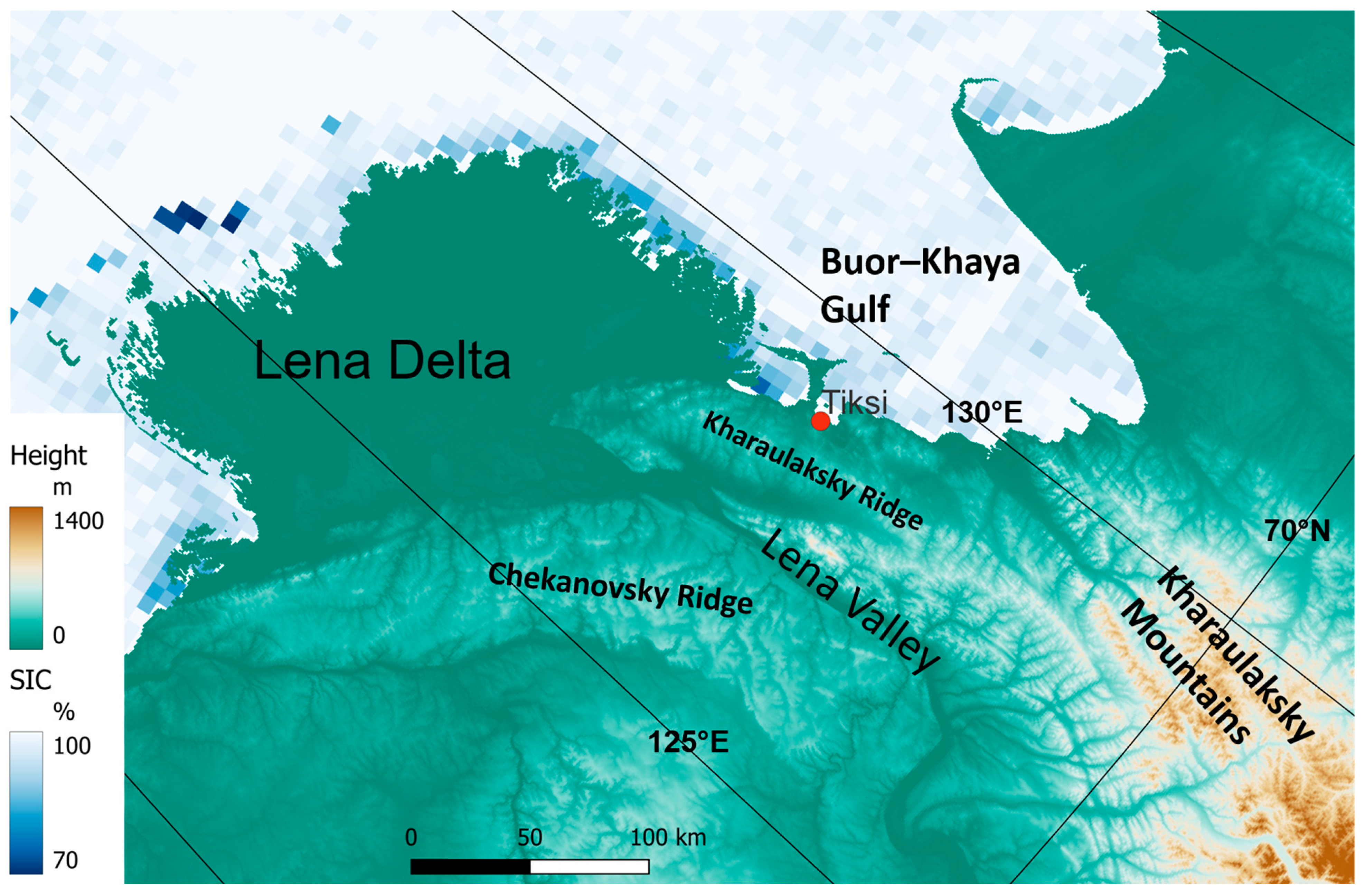
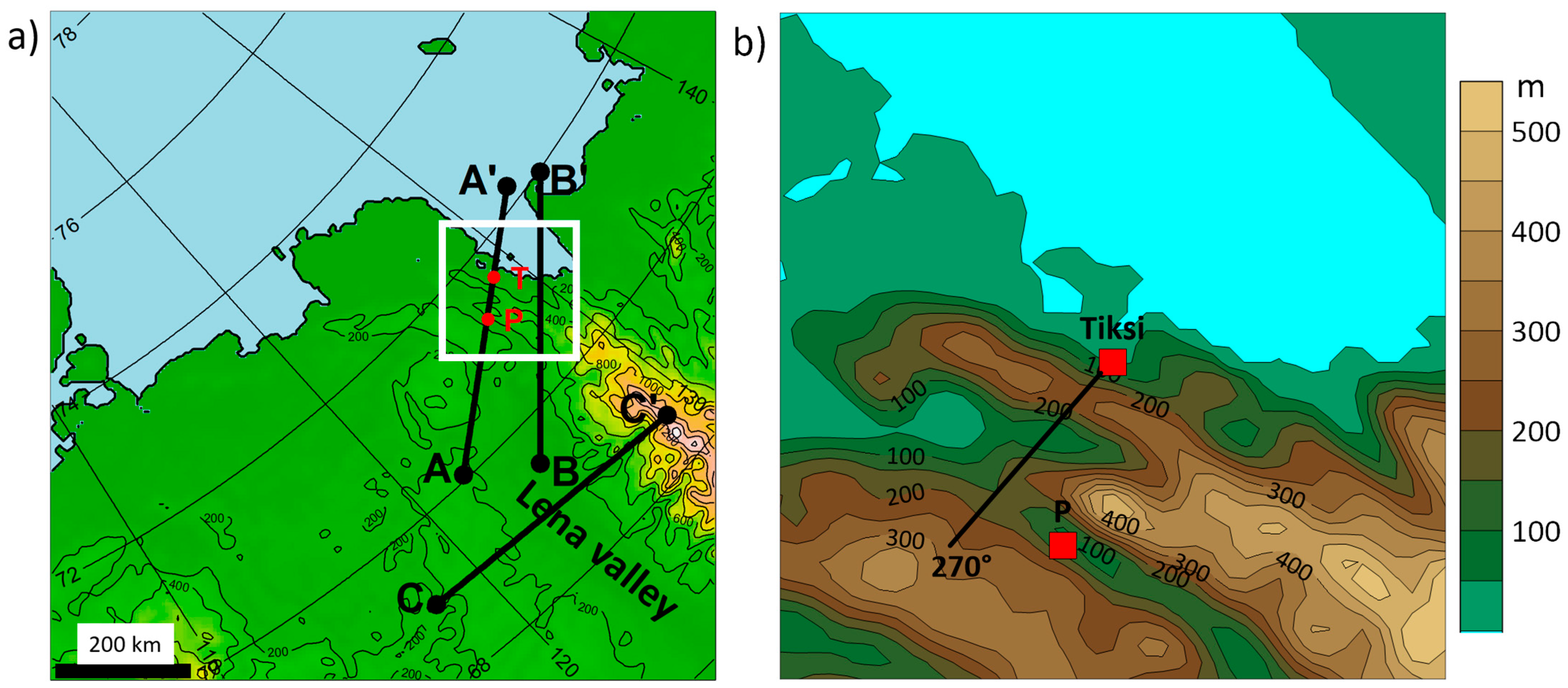


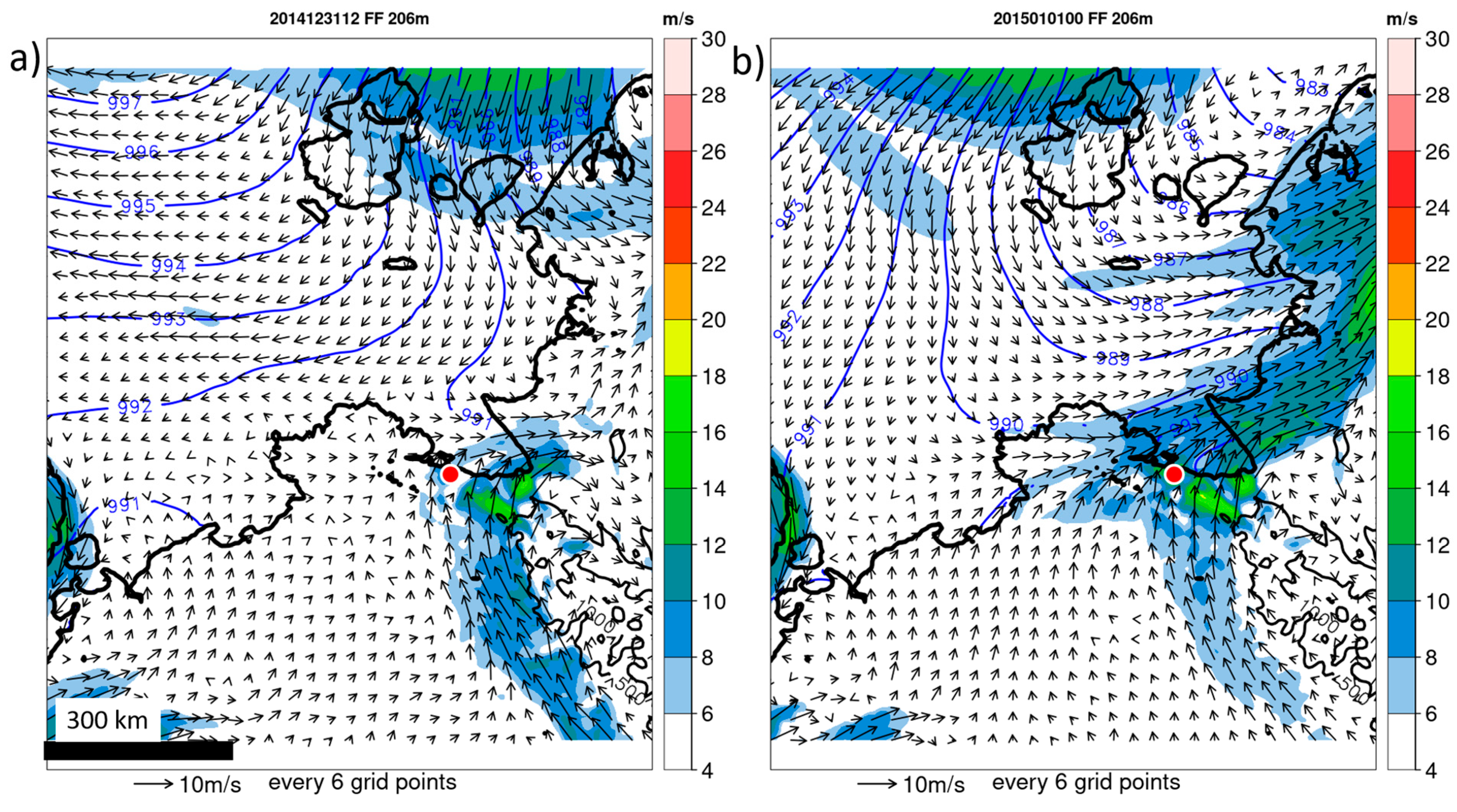

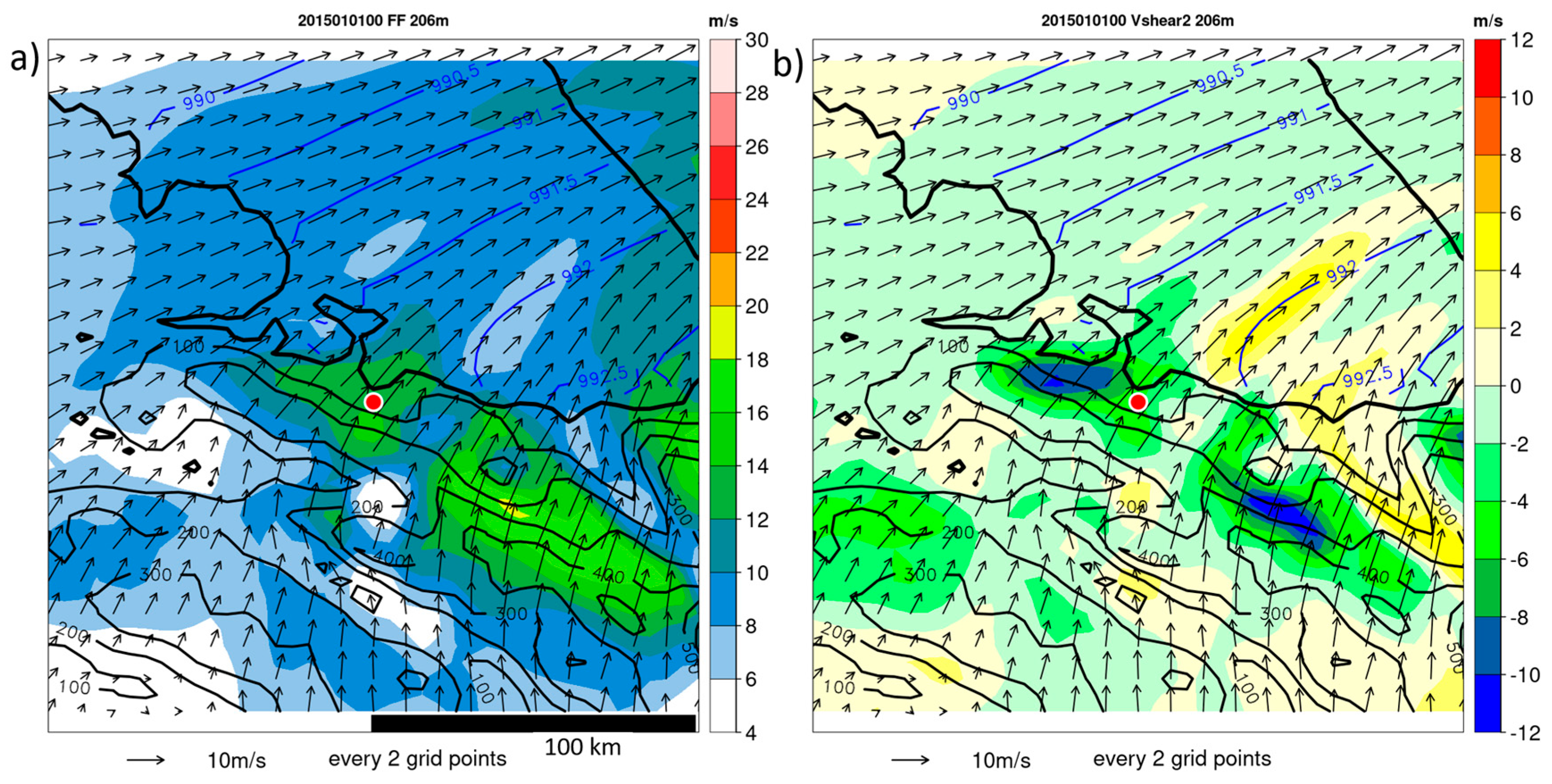
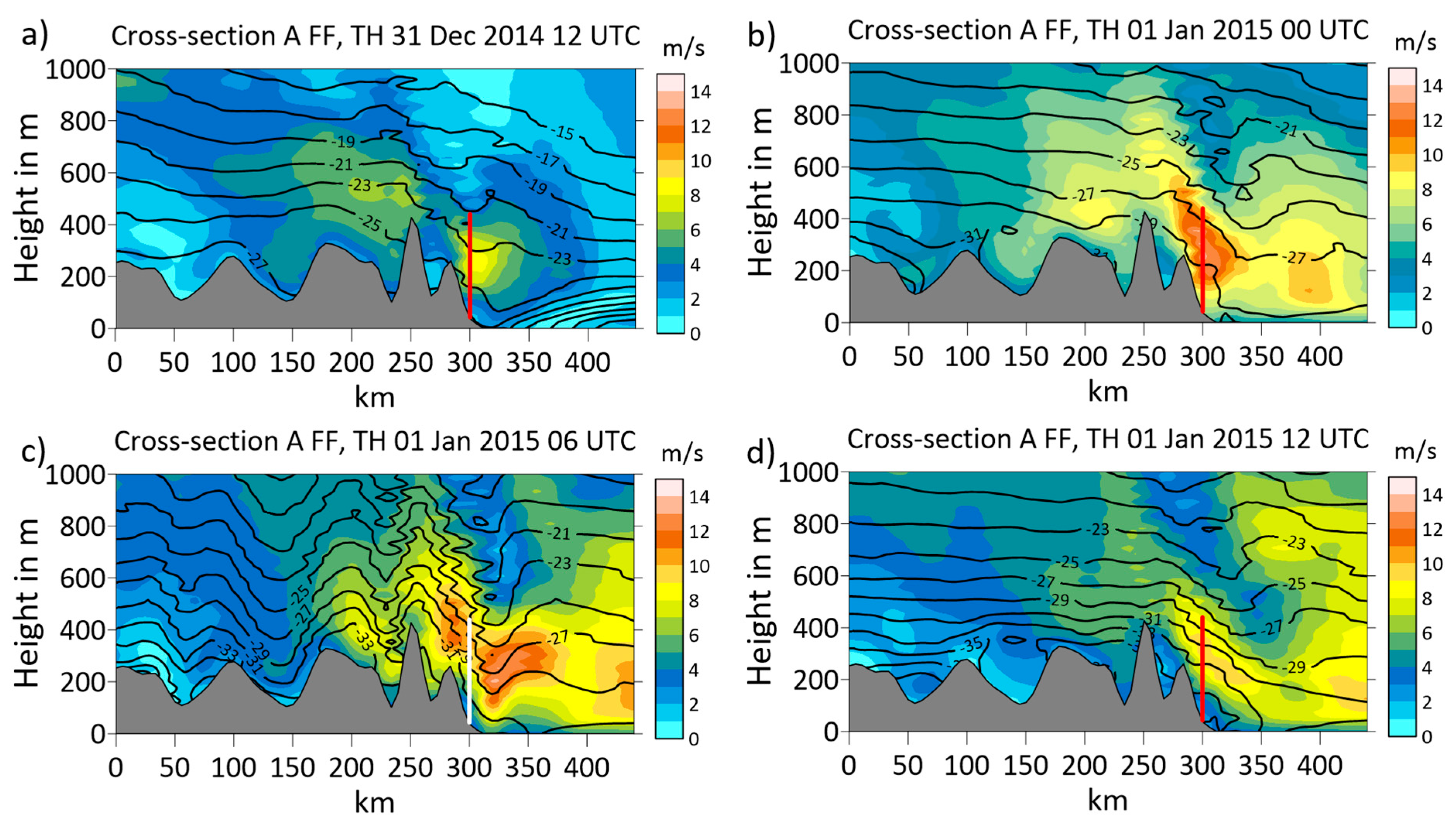
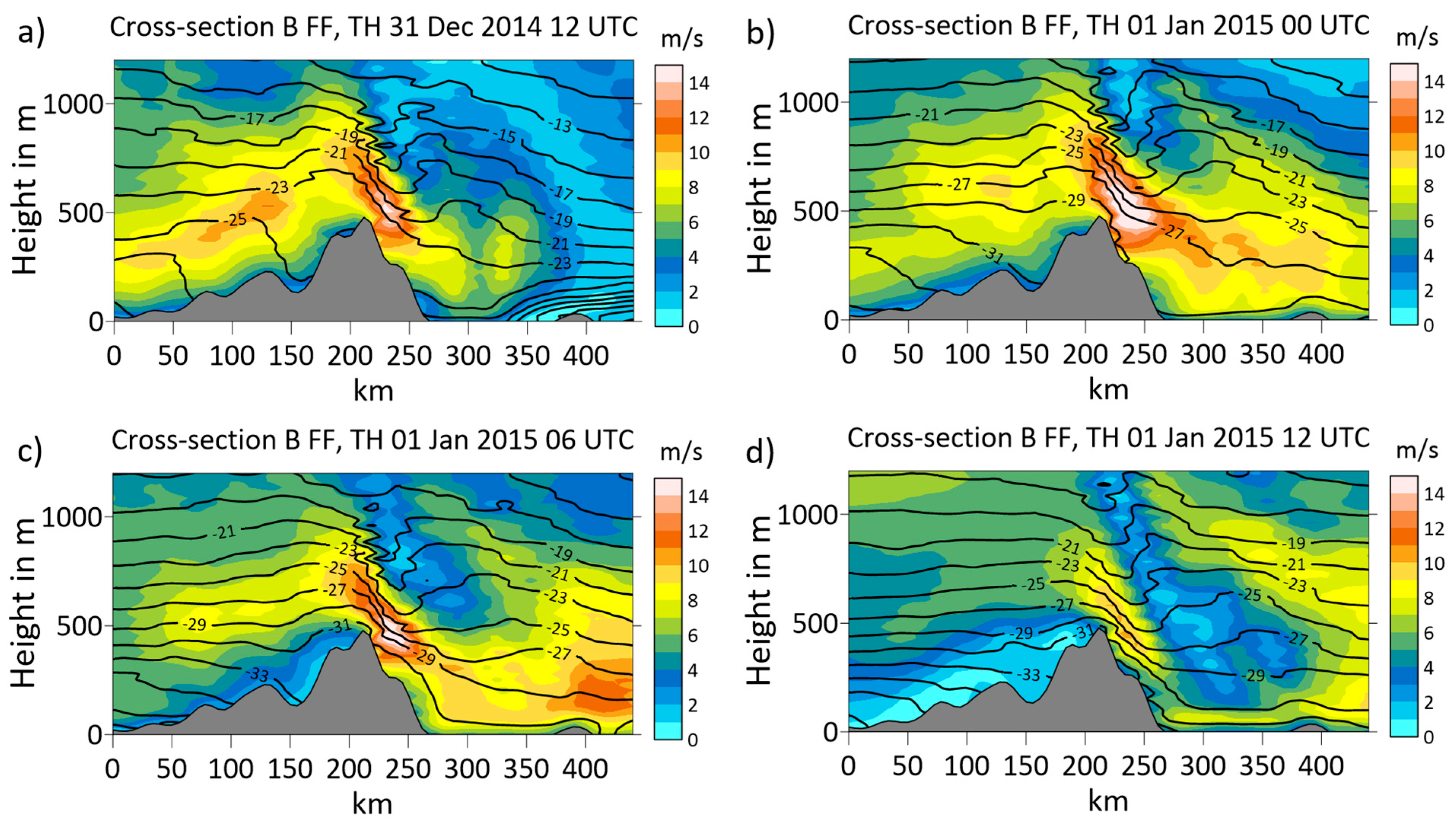
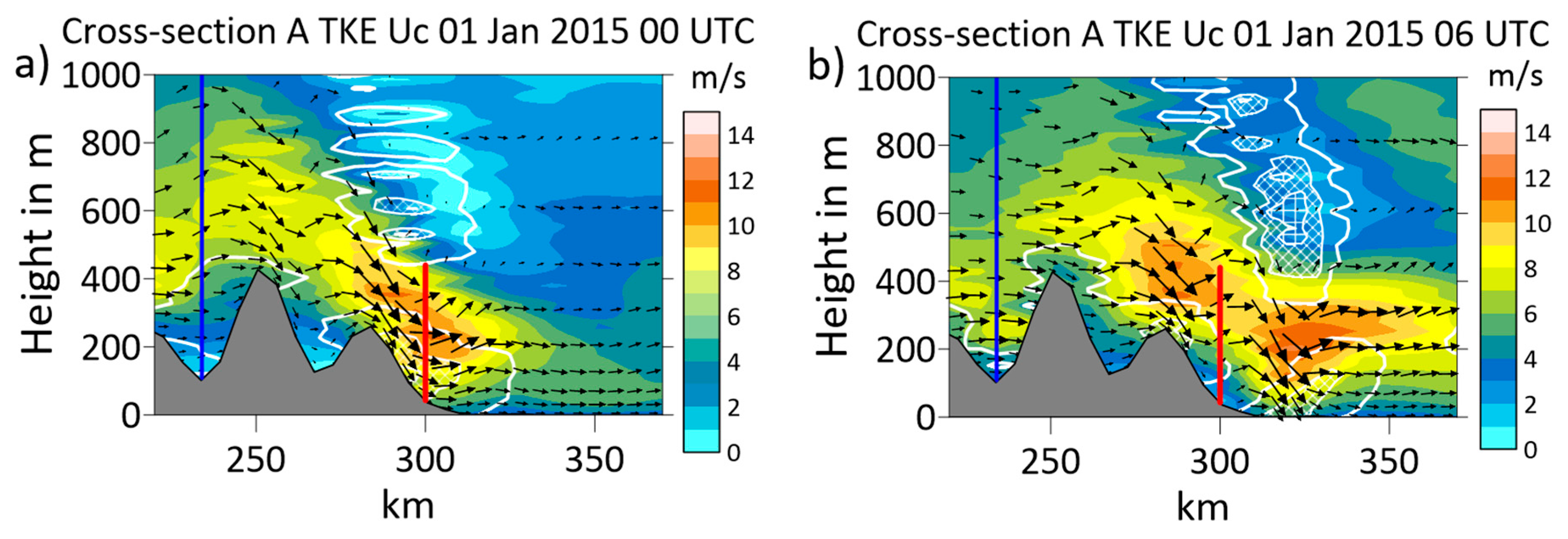
| Instrument, Owner | Variable | Height/Range | Sampling | Averaging |
|---|---|---|---|---|
| SODAR MFAS (Scintec), University Trier | 3D wind profile, wind variances | 30–550 m | 20 min | 1 h |
| windRASS extension (Scintec), University Trier | Temperature profile | 40–250 m | 20 min | 1 h |
| Standard synoptic observations, Roshydromet | Pressure, 2 m-temperature, 10 m-wind | 3 h | ||
| Tower, NOAA | Wind profile temperature profile humidity profile | 4, 9, 15, 21 m 4, 8, 12, 14, 16, 20 m 2, 6, 10 m | 1 min 1 min 1 min | 1 h |
Disclaimer/Publisher’s Note: The statements, opinions and data contained in all publications are solely those of the individual author(s) and contributor(s) and not of MDPI and/or the editor(s). MDPI and/or the editor(s) disclaim responsibility for any injury to people or property resulting from any ideas, methods, instructions or products referred to in the content. |
© 2025 by the author. Licensee MDPI, Basel, Switzerland. This article is an open access article distributed under the terms and conditions of the Creative Commons Attribution (CC BY) license (https://creativecommons.org/licenses/by/4.0/).
Share and Cite
Heinemann, G. A Case Study of a Wintertime Low-Level Jet Associated with a Downslope Wind Event at the Tiksi Observatory (Laptev Sea, Siberia). Meteorology 2025, 4, 7. https://doi.org/10.3390/meteorology4010007
Heinemann G. A Case Study of a Wintertime Low-Level Jet Associated with a Downslope Wind Event at the Tiksi Observatory (Laptev Sea, Siberia). Meteorology. 2025; 4(1):7. https://doi.org/10.3390/meteorology4010007
Chicago/Turabian StyleHeinemann, Günther. 2025. "A Case Study of a Wintertime Low-Level Jet Associated with a Downslope Wind Event at the Tiksi Observatory (Laptev Sea, Siberia)" Meteorology 4, no. 1: 7. https://doi.org/10.3390/meteorology4010007
APA StyleHeinemann, G. (2025). A Case Study of a Wintertime Low-Level Jet Associated with a Downslope Wind Event at the Tiksi Observatory (Laptev Sea, Siberia). Meteorology, 4(1), 7. https://doi.org/10.3390/meteorology4010007







